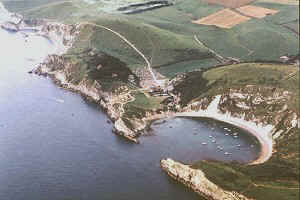Purbeck Coast, Dorset World Heritage Area

The Purbeck Coast he youngest rocks in the Devon & Dorset World Heritage
Site
- Weymouth to Ringstead. To the east of Weymouth the coast
is made up of a complex sequence of rocks, which have been jumbled up by folds
and faults. The cliffs are formed from Upper Jurassic clays, limestones and
sandstones. The coast around Osmington is famous for a natural seep of oil
from the seabed. The rocks once formed an oil reservoir that has been breached
by erosion. On a calm day, oil can still be seen seeping onto the surface
of the sea near Bran Point, between Osmington Mills and Ringstead. The coast
around Osmington Mills is a good place to see trace fossils. These are the
fossilised burrows made by ancient marine animals.

- Lulworth Cove. Lulworth Cove where a perfect horseshoe
bay has developed where a stream cut through the limestone and let the sea
enter the valley and hollow out the softer clays lying behind the limestone
barrier. The Cove is one of the most famous features within the World Heritage
Site. Another bay is forming beside Lulworth at Stair Hole, where the breach
has been made by collapsing caves and arches. Half a mile west of Lulworth
Cove is Durdle Door - a perfect coastal arch. The arch shows how nature creates
landforms that are self-supporting. The
Fossil Forest can be seen east of Lulworth Cove on a wide ledge in the
cliff. The coast between Lulworth and Kimmeridge lies within a military firing
range and access to the area is restricted. The range walks are open through
most weekends of the year and during the school holidays.
- Kimmeridge. The rocks at Kimmeridge Bay were in the Jurassic
period, 155 million years ago, on the bed of a deep, tropical sea. The sequence
of rocks here an excellent record of this part of the Jurassic and geologists
have adopted Kimmeridgian as the term for rocks of this age all around the
world .Hammering is forbidden here and you may only collect loose fossils
from the beach. BP's 'nodding donkey' has been producing oil since 1959. The
oil formed in rocks on a stagnant sea floor. The rocks were buried and organic
matter within them formed oil and gas.This is the Wytch Farm Oilfield, the
largest onshore oil field in the UK.
- Durlston. Durlston Head has the Victorian Durlston Castle
on top, with views of the English Channel, Durlston Bay and the Isle of Wight.
Durlston Castle was part of George Burt's failed attempt to build a series
of grand houses here in 1862.Massive limestone cliffs run east from St Aldhelm's
Head. A geological fault has brought the Purbeck Limestones down to sea level,
and the sea has created the landslipped coast of Durlston Bay in the softer
rocks.
- Swanage. The World Heritage Site finishes just beyond the
great Chalk headland of Ballard Down, and the stacks called 'Old Harry Rocks'.
The Chalk downland here is owned by the National Trust. To the east, the Needles
on the Isle of Wight are usually visible. These too are made of Chalk and
only a few thousand years ago were connected to Ballard Down. At Old Harry
Rocks were caused by the waves attacking weak joints in the chalk rock to
form arches and caves, which then collapse leaving isolated stacks like 'Old
Harry'
Purbeck-Portland Limestone. Quarried from Tilly Whim Caves,
Dancing Ledge and Winspit the Purbeck-Portland Limestone provided the building
stone for houses such as, Lulworth Castle, And Durlston Castle. It was also
shipped to London. Galleries were driven deep into the cliffs and the blocks
of stone were loaded on barges using cliff-mounted cranes. Today the galleries
are both derelict and dangerous. Two Purbeck quarries working Portland Limestone
are still open today, St Aldhelm's Quarry which provides a polished limestone
known as Spangle and the much larger Swanworth Quarry where the Portland Limestone
is quarried for aggregate.
The Purbeck Stone. Within the clays and limestones that make
up the Purbeck Beds, several feature as a source of stone, with names like Roach,
Thornback and Grub, each with their own qualities. These rocks were once worked
underground around Acton, Townsend (in Swanage) and along the coastal slopes
around Durlston. Today the stone is worked in open cast sites around Acton.
Devon and Dorset World Heritage
Coast


